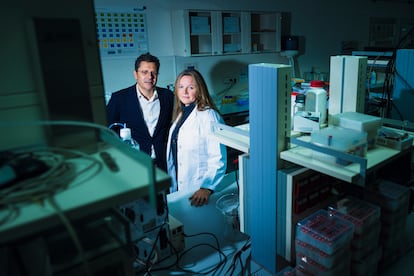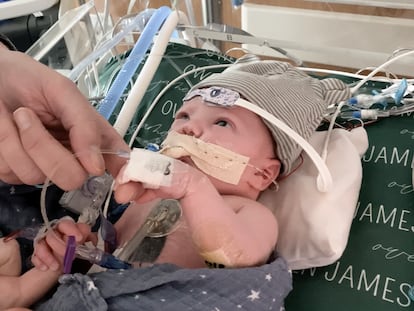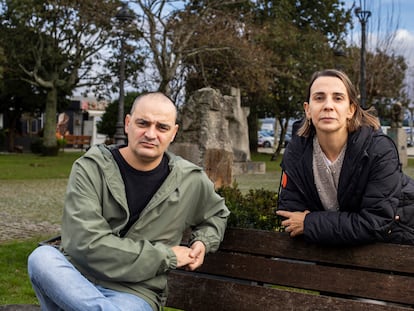Genetic autopsies to unravel the mystery of sudden deaths
Post-mortem molecular analysis can reveal hereditary cardiac pathologies that explain a sudden death without apparent cause and help prevent others

There are deaths without apparent explanation. They are not violent, nor have they been accompanied by previous symptoms that explain them, and not even the traditional anatomical post-mortem examination can find clues to the cause. They are simply sudden deaths that, in the majority of cases (about 70%), are due to a more or less hidden heart problem. Every year, between four and five million people in the world die from sudden cardiac death. In most of these situations, subsequent studies reveal some kind of coronary disease — a heart attack, for example — but there is a percentage of all sudden deaths in which forensic experts are unable to decipher the exact cause of death using traditional techniques. These are the so-called blank autopsies, where conventional anatomical examinations have been unable to return a conclusive cause of death.
In the words of some scientists, sudden death is one of “the greatest challenges of modern cardiology.” For example, 600,000 people in the United States die suddenly each year, and a study put sudden cardiac deaths in the European Union at nearly 250,000 a year. According to scientific literature, although a problem with the heart is the most common, heart failure is not always behind it: more than a third of all sudden deaths may be due to a hidden overdose, neurological failures, or hidden infections. A comprehensive post-mortem examination of the corpse is key to pinpointing the real cause of death with a high degree of certainty and potentially preventing other sudden deaths. Unmasking what is behind a sudden death can save lives, experts say.
To find out what is hidden by these sudden deaths without apparent cause, science has provided forensic medicine with new study tools, and in recent years genetic autopsies have been growing in strength and popularity. That is, a molecular analysis of the corpse to detect alterations in the genes that explain the sudden death. For example, the presence of genetic variations that are associated with various heart diseases that can cause sudden death. “When you don’t see anything, genetics finds the cause of death in around 30% of blank autopsy cases. A molecular autopsy is performed and a genetic analysis is done, and this plays a fundamental role,” explains Eneko Barbería, director of the Institute of Legal Medicine and Forensic Science of Catalonia (IMLCFC), in Spain. This institution, where all the region’s apparently unexplained deaths are investigated, has a Sudden Death Unit that uses molecular autopsies to detect pathologies linked to genetic mutations. The results of molecular autopsies may help prevent other sudden deaths caused by hereditary ailments, such as those of the victim’s relatives who may have the same genetic mutation and may also be at risk of sudden death.
The son of Ester Costafreda and Ángel Quemada died of sudden death in March 2014. He was only 15 years old. One night he went to bed and never woke up. “He died in his sleep, with no symptoms of anything and without us understanding anything at all, because we had no warning. This is how our whole journey began,” says his mother. She is now manager of the Association of Arrhythmic Syndromes Related to Sudden Death (SAMS) and is dedicated to helping survivors and relatives of those who died suddenly due to hereditary heart disease.
Post-mortem studies, including a genetic autopsy, revealed that the young man suffered from arrhythmogenic cardiomyopathy, a hereditary disease that can cause sudden death. “We can say that it is a family disease. The heart develops scars and that prevents the proper flow of electricity through the heart. And that can cause arrhythmia [a disorder of heart rate and rhythm that can lead to death],” Quemada explains. The cardiological and genetic tests that the family underwent after the boy’s death also showed that another relative was suffering from the same disease and has already received an automatic defibrillator implant that can restore a regular heartbeat in case he suffers a sudden arrhythmia. “While we did not know that there was another affected person in the family, we were also at risk. In other words, the moment I found out that another relative of mine had this disease, I didn’t sleep until they implanted the defibrillator because he could have died at any time. This whole process must be done as quickly as possible,” Costafreda says.
Young people dying unexpectedly
In the heart of an imposing building on the border between Barcelona and L’Hospitalet de Llobregat, Spain, scientists have gathered every scrap of evidence in an effort to find an explanation for the sudden deaths. “A lot of the time it is young people, who die quickly and unexpectedly. That is, they had no previous symptoms, they are apparently healthy people. Therefore, when death occurs, no doctor wants to sign the death certificate. So it is communicated to the court on duty, the entire investigation is launched and it is made into a case for the courts,” explains Marisa Ortega, head of the IMLCFC Pathology Service.
Every detail is carefully studied. From the same place of death, Barbería points out: “An autopsy goes beyond what people believe it is. The internal examination and scalpel that everyone has in mind is just one phase of the autopsy. What we really do is integrate a lot of information that begins at the scene of the event, where we collect the clinical evidence, if there is a family history [and so on].” This data is added to what is obtained from the traditional autopsy — where a macroscopic analysis, a study of the tissues, and toxicological and biochemical examinations are undertaken — and it is integrated with the information reported by other complementary tests, such as genetic analysis.
“We do 4,500 autopsies a year in Catalonia. Of these, approximately 60% are deaths from natural causes and of these deaths, 75% are sudden deaths, which occur quickly and unexpectedly. From there, we have a cut-off point for age: over and under 50 years old. The majority are people over 50 years of age who mainly die from coronary heart disease. And then we have a lower percentage in the group of those under 50 years of age, around 20% or 30%, in which we usually find pathologies that may be of a more genetic type,” explains Barbería. In this last group, genetic autopsies can provide crucial information, and international forensic medicine guidelines recommend using them, says the coroner.
A study published in The Lancet elaborates on this line and recommends “strengthening” the availability of autopsies to provide “crucial data for families at risk.” According to the authors, determining whether a sudden death is of cardiac origin and the exact underlying cardiac cause has important implications when it comes to providing a cause of death. This, in turn, is helpful to clarifying future risks for family members.
The researchers point out that if a cause is determined to be hereditary, preventive measures can be taken, while if it is non-hereditary (for example, myocarditis), the family members have peace of mind knowing that they are not at risk.
Cardiologist Ramon Brugada, who implemented cardiac genetic studies in Catalonia, explains that there are two groups of diseases associated with sudden cardiac death: coronary heart diseases, such as heart attack, especially in those over 35 years of age; and diseases in younger people, under 35, which are usually hereditary. In this group, heart tissue ailments may occur, such as hypertrophic cardiomyopathy; but there can also be channelopathies, which are dysfunctions in the channels that create electricity in the heart; and vasculopathies, which manifest themselves with a larger than normal aorta that, when ruptured, causes death in seconds. “Unfortunately, most hereditary diseases are discovered after a first death in the family,” says the doctor, who is a researcher at the Girona Biomedical Research Institute (IDIBGi).
Given a suspicion of a death due to a hereditary disease, the IMLCFC Sudden Death Unit operation has been launched and is coordinating with Brugada’s team. Forensics take blood samples from the deceased, and specialists from the IDIBGi cardiovascular genetics diagnostic laboratory analyze them. “We have a panel of 200 genes associated with sudden death. We analyze them and can detect if there is a mutation that has caused sudden death. If there is a mutation that is 100% associated with sudden death, then you do a genetic study on the family and you also discover the genetic carriers of the disease and those who do not. Being a carrier does not mean developing it, but it is more likely,” explains Brugada.
Experts assume the genetic study is not always conclusive, but it does help to unravel the mystery of at least some of those blank autopsies. Brugada admits that not all the genes involved are known, but of the 140 cases they receive a year, they find a genetic cause associated with a disease in 20%. “We have a panel of 200 genes, but that is not all of them. We only know 50% or 60% of the genes associated with sudden death,” he explains.
Inform families
When scientists at the IMLCFC find a genetic anomaly that explains the origin of a sudden death, they inform the family members and advise them that the death was caused by a hereditary disease and that they may be carriers of the gene associated with sudden death. “One of the reasons why we started as a functional unit is to humanize ourselves a little more. [Judicial investigations into sudden deaths] always seems cold and distant. And in these situations we want to get a little closer,” explains Barbería.
Relatives’ responses to a positive result are variable, admits the director of the IMLCFC. “I see a state of confusion and uncertainty. We are trying to convey the need for them to look at themselves, but without alarming them,” he explains. With this information in hand, there are families who choose to visit a specialist and analyze their real risk, while others reject it outright, says Costafreda. The SAMS foundation provides support and attention to family members and survivors: “They are terribly afraid. They come to us scared to death. One girl told me: ‘I just don’t want to go to sleep!’ You meet patients who are asking you for support,” she says.
Sign up for our weekly newsletter to get more English-language news coverage from EL PAÍS USA Edition
Tu suscripción se está usando en otro dispositivo
¿Quieres añadir otro usuario a tu suscripción?
Si continúas leyendo en este dispositivo, no se podrá leer en el otro.
FlechaTu suscripción se está usando en otro dispositivo y solo puedes acceder a EL PAÍS desde un dispositivo a la vez.
Si quieres compartir tu cuenta, cambia tu suscripción a la modalidad Premium, así podrás añadir otro usuario. Cada uno accederá con su propia cuenta de email, lo que os permitirá personalizar vuestra experiencia en EL PAÍS.
¿Tienes una suscripción de empresa? Accede aquí para contratar más cuentas.
En el caso de no saber quién está usando tu cuenta, te recomendamos cambiar tu contraseña aquí.
Si decides continuar compartiendo tu cuenta, este mensaje se mostrará en tu dispositivo y en el de la otra persona que está usando tu cuenta de forma indefinida, afectando a tu experiencia de lectura. Puedes consultar aquí los términos y condiciones de la suscripción digital.
More information
Últimas noticias
Most viewed
- Sinaloa Cartel war is taking its toll on Los Chapitos
- Oona Chaplin: ‘I told James Cameron that I was living in a treehouse and starting a permaculture project with a friend’
- Reinhard Genzel, Nobel laureate in physics: ‘One-minute videos will never give you the truth’
- Why the price of coffee has skyrocketed: from Brazilian plantations to specialty coffee houses
- Silver prices are going crazy: This is what’s fueling the rally











































